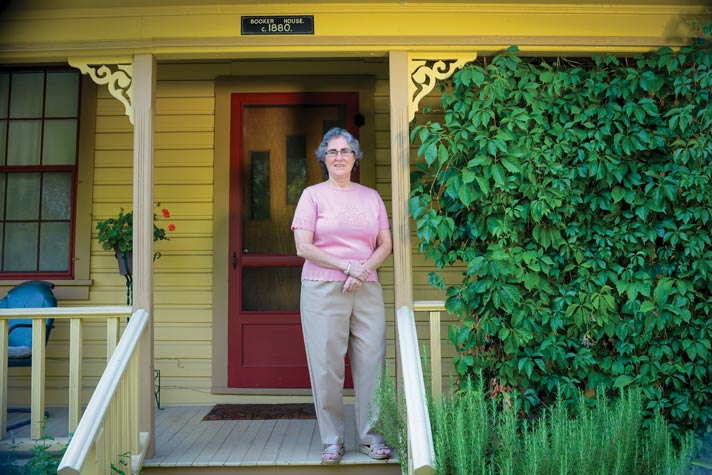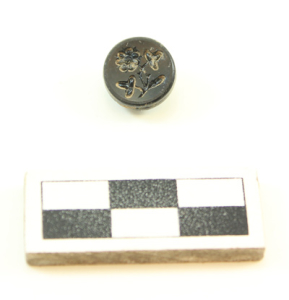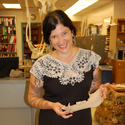Digging Jacksonville – September 2015
This “mourning button” is one of the many artifacts found during repairs to my own home, the historic Booker House on South Oregon Street. Black attire, including buttons, was popularized by Queen Victoria following the death of her husband, the beloved Prince Albert. She reportedly wore mourning clothes for the rest of her long life.
The Victorian era and its mourning rituals were formalized into strict rules of etiquette which included not only dress, but funeral procedures and social behavior, depending on how you were related to the deceased. While these were adhered-to by royalty, they were often impractical for the majority of people. Still, common custom was to wear black for some period of time to show your love and loss. Jacksonville was far removed from England, yet people still wanted to show respect for a lost loved one and to demonstrate their grief.
While this button is interesting, where it was found (its archaeological context) brings it to life, especially for me. Otto Biede and his family lived in this house in the early 1890s. They had two daughters, Helene (born in 1886) and Gertrude (1889). On the first of June in 1891, Mrs. Biede (Marie) gave birth to a boy they named Johannas; but his was to be a short life. On August 16th he passed away and was buried in the Jacksonville Cemetery. While the family could not place a traditional gravestone, their love for the baby is shown by the unique marker formed of heavy wire loops in the shape of a cradle and set in a durable wood.
Gertrude lived to be 108, spending her adult life in Ashland, but she often visited the grave. As she described it in 1978, “Before we left Jacksonville in 1901 my mother planted some ivy on my brother’s grave. In all these years it has never died out nor grown beyond the grave. On Memorial Day it is always green and it seems strange that it does not spread.”
Just in recent times it has disappeared—perhaps at the hand of a well-intentioned cemetery worker.
Black buttons, of course, were used on other attire, but were often advertised in catalogues as “mourning buttons.” It is quite possible that Mrs. Biede wore this button on her clothing as she mourned the loss of her only son, who was to be her last child.
The identification of the button was made possible through my collaboration with the SOU Laboratory of Anthropology (SOULA) during home repairs. Their work was invaluable to me. They also helped me identify artifacts (such as a Native American thumb scraper made of jasper and a Chinese opium tin lid) and educated me on the importance of context to paint a fuller picture of the history of my property. Funds that I granted to SOULA provided work/study for a student who cataloged the hundreds of artifacts recovered.
Carol Knapp has lived in the c. 1880 Booker House since 1978. She is a retired RN who served in the US Navy during the Vietnam War. She believes that the history of Jacksonville and its feeling of continuity with the past are what makes the town unique and keeps it vibrant. You can reach SOULA by contacting Chelsea Rose at rosec@sou.edu and follow SOULA on facebook/Southern Oregon University Laboratory of Anthropology.
Featured image of Carol Knapp ©David Gibb Photography & Design


 Chelsea Rose is an historical archaeologist who specializes in the settlement and development of the American West. Chelsea and the Southern Oregon University Laboratory of Anthropology (SOULA) conduct archaeology across Oregon and have done several projects in Jacksonville. You can reach Chelsea at rosec@sou.edu and follow SOULA on
Chelsea Rose is an historical archaeologist who specializes in the settlement and development of the American West. Chelsea and the Southern Oregon University Laboratory of Anthropology (SOULA) conduct archaeology across Oregon and have done several projects in Jacksonville. You can reach Chelsea at rosec@sou.edu and follow SOULA on